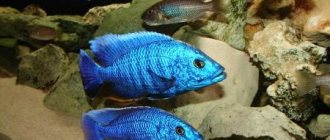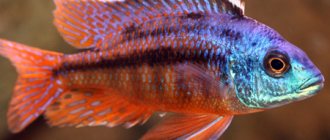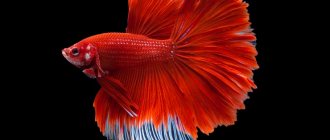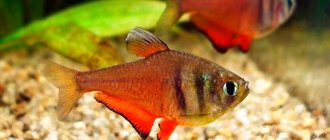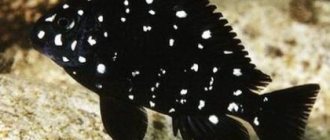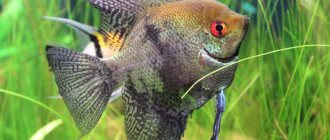Lalius (lat. Colisa lalia) is one of the most popular aquarium fish. They love her for her peaceful disposition, very bright colors in males and small size. As a rule, they grow no more than 7 cm, and females are even smaller.
This beautiful fish is suitable for all types of aquariums and decorates it incredibly. Its small size and accessibility make it a good fish for beginners.
It can live in very small aquariums, even 10 liters, but of course more volume is better. Peaceful, can be kept with almost any fish, and is easy to breed.
Description
Lalius are freshwater labyrinthine fish of the genus Colis (Trichogaster), alternative names: dwarf threadfish, rainbow fish. Bright representatives of the macropod family, having many morphs of different color variations. The species was described by wildlife taxonomist Hamilton in 1822 under the name Colisa lalia. Modern nomenclature has classified the lalius as the genus Trichogaster lalius.
Lalius are unpretentious, easy to reproduce and maintain.
The first single specimens of dwarf threadworts came to Europe from India in 1869, but the mass supply of lalius was carried out much later, only in 1903.
Russian aquarists became acquainted with rainbow fish a few years later in 1905-1907.
Appearance
These are small beautiful fish of contrasting colors.
The maximum length of an adult does not exceed 6 cm, and the number of ctenoid scale plates along the midline does not exceed 28 pieces. Description of appearance:
- The body is tall, flat, oval in shape, strongly compressed at the sides.
- The head is large with a pair of large eyes and an upper mouth. Due to the frontal notch, the snout appears sharp, short and forms a pronounced transition to the body.
- The dorsal and anal fins have long, elongated bases and are found on the tail.
- A pair of movable antennae-receptors - modified filament-like abdominal formations - are located in front of the pectoral fins.
The maximum length of an adult does not exceed 6 cm.
The natural color of the classic lalius is dominated by silver-blue. The bright pattern is represented by 13-18 vertical uneven red stripes. They run along the sides of the body and cross all the fins except the pectoral ones. The saturation in the pigment of the pattern increases from the head to the end of the body.
The color of the caudal and anal fins is dominated by red, while the dorsal fins have more turquoise and blue shades. Females also have a striped pattern, only the color is less intense. The differences in color between the male and female lalius are noticeable in the photo.
Mr. Tail recommends: varieties
Lyalius is a naturally beautiful fish. Breeders went further and bred several species with bizarre colors. They are very popular among aquarium fish lovers.
Lyalius Neon
This variety has a bright neon red body. The dorsal fin is colored blue. The content is not very difficult. Individuals prefer to hide in algae from aggressive inhabitants of the aquarium.
Lyalius Rainbow
These striped fish look impressive against the background of a dark bottom. The color alternates between red and greenish-blue. The difference between males is a brighter shade of scales, large size, oblong and pointed shape of the fins. Females are less expressive, so they are rarely sold in pet stores.
Lyalius Cobalt
The fish prefer to live in schools and grow small, up to 6 cm. The flat body of the males becomes pointed towards the head. The fins are elongated and narrow compared to ordinary ones. The color is cobalt blue; the shade of the scales changes depending on the incident light.
They get along well with peaceful breeds.
Lyalius Coral
The name suggests the shade of the scales of this species. Individuals have a capricious disposition. They are loved to be bred for their attractive appearance. With well-chosen lighting, a school of coral fish looks impressive.
Lyalius Blue
This variety is distinguished by its uniform blue color. If you look closely, you can see slight shades of red-brown dots that are combined into vertical stripes. The fish are shy, and for the first time after being introduced they hide from other inhabitants of the aquarium.
Habitat
In their natural environment, colyses live in lakes and even rice fields in India, Indonesia, Bangladesh, Singapore and Pakistan. They love warm, sun-warmed waters with soft water and dense underwater vegetation.
In nature, colizas live in lakes and even rice fields.
In the wild, laliuses are omnivores and enjoy feeding on larvae, fry and worms, and also successfully hunt insects: swimming to the surface of the water surface, the fish looks out for prey and, as soon as the target is detected, knocks it down with a stream of water.
Nature has endowed the phenotype with an additional tactile organ - whiskers, thanks to which the fish analyzes the environment.
Feeding
Lalius are not picky about food and are practically omnivorous. In nature, they feed on plant food and small larvae. The best way to feed your fish is:
- Daphnia;
- bloodworm;
- cyclops;
- tubifex;
- artemia;
- koretra.
Ready-made dry flakes or granules are suitable as food. The fish are fed once a day. At the same time, they arrange a fasting day once every 7 days. Lalius are practically insatiable, so it is important not to overfeed these underwater pets .
Behavior and character
Lalius are shy and cautious aquarium fish that do not like fuss. They prefer to live in schools in the surface horizons of the aquarium. Males are territorial. They often sort things out among themselves, demonstrating aggressive behavior towards their own kind.
Lalius are shy and cautious aquarium fish
How and what to feed lalius
The owner should take care of a balanced and nutritious diet for his bright charges. The menu can be composed of live, frozen, plant foods. It is important to consider that lalius swallow most of their food from the water surface, so the best food for them is flake diets. They do not immediately dissolve and drown, floating on top for some time. But the product should not float for long, since uneaten particles begin to rot and decompose, polluting the aquatic environment.
Fast-sinking food is not suitable for these fish; lalius rarely sink to the bottom. If some of the food does settle, it is worth considering the envy of the cleaner fish - corydoras, which will clean the soil from food remnants. Lalius are gluttons and are able to absorb much more food than they need. Therefore, the owner should dose the food - this will prevent the fish from overeating.
Kinds
The colorful color of natural rainbow fish prompted breeders to conduct genetic experiments. The result of the work done was the production of a large number of mutations with a beautiful variety of colors.
All subspecies have the same body and fin shape, are mostly the same size and have similar maintenance requirements.
The color of lalius in an aquarium depends not only on the variety, but also on the spectral characteristics of the lamp equipment.
Lyalius red neon
A bright and popular morph with a metallic tint, it is considered the most unpretentious of all breeding forms. The neon threadworm is a deep red dominant color with a contrasting blue snout, belly and upper body. The dorsal fin is decorated with a blue crest, the anal fin with small gray-blue inclusions. All fins, except the pectoral ones, have a thin fiery red edge. The striped pattern is not pronounced, the saturation of the main pigment appears from head to tail.
The most unpretentious species of all breeding forms
Lalius blue dwarf
The main color of the fish’s body and fins is blue-blue with a silver-violet tint. The pattern on the sides of the blue dwarf lalius is represented by transverse, sometimes intermittent, terracotta-red stripes. All fins, except the pectoral ones, are decorated with a clear edging, lines and inclusions that match the stripes on the body.
Motherland
When choosing lalius fish, care and maintenance are the determining factors in acquiring this representative of the fauna. Fish, whose homeland is Indian, Indonesian and Bangladeshi waters, have been known since the 30s of the 19th century. The colorful fish were discovered by researcher Francis Hamilton, and a little later, thanks to the French aquarist Pierre Carbonnier, lalius spread throughout Europe.
For habitat, laliuses prefer to choose stagnant waters of small lakes and streams. The fish are slow and timid, so they spend a lot of time buried in dense, near-bottom thickets.
In an artificial reservoir, it is necessary to provide the lalius with many natural shelters in the form of various plants.
Lyalius have a bright appearance. You can recognize fish by the following signs:
- oblong body, flattened at the sides;
- long anal and dorsal fins extending from the head itself;
- filamentous pectoral fin, which is in constant motion and acts as tactile organs;
- tail forked and rounded at the end;
- blue-blue stripes run across the greenish-blue body;
- reddish spots on the surface of the fins.
Sexual differences between opposite individuals are clearly expressed. Males are slightly larger in size, brightly colored, and have a more pointed dorsal fin. The color of females is not so bright, and the abdomen is fuller.
The male lalius, as is often the case in the world of fish, is larger and brighter than the female.
Lalius belong to the labyrinthine family. They, like gourami, have an auxiliary respiratory organ - a labyrinth. Thanks to this, lalius have the opportunity to breathe atmospheric air while at the surface of the water.
The Lalius also has a common way of feeding with gouramis. Representatives of both species freeze when they notice prey. When an insect approaches, they shoot a stream of water at it and, after a fly or mosquito falls, they eat it.
How to choose a fish
The priority when choosing colis should be the acquisition of healthy and young individuals.
Sick fish can be identified by:
- pale, uneven color;
- glued, unstraightened fins;
- spots, ulcers or plaque on the integument.
It is better to refuse to buy large, showy specimens. The life of the lalius is short-lived; most likely, adult fish will not bear offspring and will live for another 1-2 years. The young animals grow quickly and soon also become beautiful, but will please their breeders for much longer.
It is better to refuse to buy large fish specimens
When planning the purchase of color morphs, it is important to know that the phenotype of selected breeds is not always stable. Without special food, some varieties of rainbow fish may gradually return to the classic color of their natural form. In the first generation, the hybrids produce standard laliuses, and the recessive coloration appears only in some males in the second brood.
Maintenance and care
Both classic and hybrid lalius, the maintenance and care of which is not difficult, can be recommended to beginning aquarists. Even a small herbal aquarium and a minimum of care - basic maintenance and feeding - are suitable for rainbow fish.
Aquarium
An aquarium of 15-25 liters is sufficient for a pair of dwarf threadtails. When kept in a school, the volume is increased in proportion to the number at an approximate rate of 10 liters per individual.
For a group of 5 adult laliuses, a 40 liter aquarium is suitable.
For these fish, spacious structures will be preferable because:
- increase swimming activity;
- do not interfere with physiological development;
- reduce the likelihood of territorial conflicts.
The aquarium is equipped with a lid that will accumulate warm air above the water and maintain a favorable microclimate of the aqua system.
To prevent labyrinthine species from getting sick, the temperature of the air masses and water must be the same. A tank with rainbow fish is placed in a quiet place with minimal traffic, since the phenotype is shy and begins to become very anxious in a noisy environment.
It is better to place an aquarium with rainbow fish in a quiet place
Filtration
Lalius have a good appetite, which means that the content of organic pollutants in the environment will be high. To ensure that the water quality remains acceptable before the scheduled replacement, suitable cleaning equipment is installed in the aquarium:
- internal filter - suitable for small structures;
- external filter - installed in large multi-species aquariums;
- phytofilter is a two-stage system.
In terms of performance, equipment is selected in accordance with the volume of the tank. With models of higher power, in this case it will be problematic to provide comfortable conditions for rainbow fish.
Colises do not like strong currents, so the pressure coming out of the filter must be weakened with special nozzles or cleaning elements must be installed so that the stream breaks against the glass.
Cleaning equipment must be installed in the aquarium.
Contents
There is a very common belief that aquarium fish are one of the most unpretentious pets, and caring for them takes almost no time. In fact, the majority of fish, especially the most beautiful and large ones, require rather specific conditions of detention. And the aquarium itself must be cleaned and washed regularly.
Therefore, many novice amateur aquarists who do not take this fact into account later face a number of problems. In order to avoid this, beginners need to start with fish species that are truly less demanding in terms of keeping conditions and are patient with some mistakes of an inexperienced owner. For example, for starters, you can purchase aquarium fish such as lalius.
Lalius are decorative fish of the labyrinth family. Their sizes usually do not exceed 6 centimeters. Aquarium fish Lalius have a beautiful bright color, which is more pronounced in males. An aquarium with a volume of about 20 liters is quite enough for a pair of lalius. If you want to purchase a flock of Lalius, where there will be several males, then the volume of the aquarium should be at least 60 liters.
This is because males will share territory and can be quite aggressive towards each other, especially during the spawning season. If the male Lalius have enough space, then the division of the territory will take place quickly and quite peacefully. Also, the aquarium should have a lot of plants, including floating ones, since lalius live mainly in the upper layers of water. In addition, the male will use plants when building a nest. You can put a small layer of soil or sand at the bottom. Lalius are quite tolerant of temperature changes, but it is still better to maintain a constant temperature of at least twenty degrees, approximately 22-28°C. It is better to cover the aquarium loosely with glass so that the fish do not catch a cold.
In general, lalius are very delicate fish, but lalius do not have any special diseases. The only problem is peptic ulcer disease. An ulcer appears on the pet's body, usually on the back, and in most cases this leads to the death of the fish. Experts disagree on the definition of this disease, most often it is considered to be tuberculosis. If you start treatment at the earliest stage, the likelihood of recovery is much higher.
It also sometimes happens that the lalius lies at the bottom of the aquarium. This can either be a manifestation of stress or a sign of illness. In any case, it is better for you to consult with a specialist who will tell you what medications and what treatment your pet needs. At this time, the fish must be placed in a separate container.
What else to pay attention to
Wild specimens have innate qualities to survive in difficult natural conditions. Aquarium representatives partially lose such abilities and need an environment favorable to the species. In addition, the artificially limited habitat of rainbow fish requires the breeder to correctly select the intraspecific composition for one aquarium.
Group content
Colises are gregarious inhabitants of tropical waters. In an aquarium they feel better in a group of 6-10 individuals. Single or pair housing is uncomfortable for lalius due to the sensitivity of the phenotype.
Colises feel better in a group of 6-10 individuals
Sex composition
With puberty, males begin to display territorial aggression towards their own kind. In nature or in spacious aquariums, such local problems, as a rule, are solved quickly - the weak individual swims away to a safe distance. In other situations, peaceful coexistence in a group of Lalius is achieved due to the superiority of the number of females over males, the so-called “harem” keeping.
From an aesthetic point of view, the male individual is of the greatest interest due to its beautiful and bright color. But a quiet life in the biotope will be achieved if there are 2-3 or more females per adult male. This gender composition will help reduce the likelihood of conflict situations, and the number of females is limited only by the volume of the aquarium.
Comfortable conditions
Cautious dwarf threadworts do not tolerate fuss and aggression in their environment. Therefore, these fish can only be kept with peace-loving neighbors and with a sufficient number of places where the lalius could hide.
Since the species occupies predominantly the upper layers, waterfowl plants must be placed in the aquarium. Lalius are biologically tied to this type of aquaculture.
Waterfowl plants must be placed in the aquarium
If there are a large number of plants and a minimum number of fish, the aquarium may not be equipped with a filter. It creates an undercurrent that rainbow threaders do not like.
Individual character
A predisposition to anxiety and a sense of vulnerability plunges Lalius into stress. And this has an extremely negative effect on the general condition of the fish and significantly reduces their immunity.
Features of aquarium maintenance
These small pets can live in a 10-liter container. But experienced aquarists still recommend purchasing a 50-60 liter aquarium for 3-4 individuals. In addition, the needs of the Lalius should be taken into account so that they live comfortably:
- the temperature of the water in the tank should be room temperature; sudden changes will not benefit these inhabitants;
- Lalius belong to the labyrinth fish, so they need to frequently capture oxygen from the surface - if the air and water temperatures are different, the labyrinth apparatus of the individuals may be damaged;
- It is advisable to cover the aquarium with a lid - this will protect the fish and help them avoid hypothermia;
- it is worth protecting them from strong currents;
- filtering water is desirable, but not necessary;
- the container should contain dense vegetation, including floating vegetation, shelters, grottoes and caves;
- The aquarium should be placed away from noise and bright light sources;
- a male should have several females - this will reduce the likelihood of conflict situations;
- Water that meets the following parameters is considered suitable: temperature – 24°-28°С, pH – 6.0-8.0, hardness – 5-18 dGH.
Compatible fish species
Due to their peaceful nature, Lalius get along well with calm phenotypes, but are vulnerable to aggressive species.
| Compatible | Limited | Incompatible |
| Cherry barb | Bocia | Astronotuses |
| Guppy | Gourami | Akary |
| Danio | Discus | African cichlid |
| Corridoras | Cardinal | Barbus |
| sword bearer | Congo | gold fish |
| Minor | Labeo | Koi |
| Mollies | Macropod | Red parrot |
| Neon | Cockerel | Nothobranchius |
| Pecilia | Parrot | Piranhas |
| Rainbow | Ternetia | South American cichlids |
| Rasbora | Acne | |
| Angelfish | Chromis | Cichlazomas |
Lalius also demonstrates compatibility with adult gastropods. In addition, snails are considered the orderlies of the aquarium and will pick up the remains of uneaten food after the fish.
Snails will pick up leftover food from fish
Relatively compatible species
It is not possible to immediately draw clear conclusions about every neighborhood. Sometimes even incompatible species, under certain conditions, get along well together. For a peaceful life, it is important to provide the fish with sufficient food and shelter and to prevent overcrowding in the aquarium.
Cockerel
Beautiful labyrinth fish of the macropod family. They are not predators, but are famous for their high intraspecific aggression, which they also demonstrate towards other fish. You can try combining them with lalius in a spacious aquarium zoned with tall vegetation.
You can try combining a betta with a lalius in a free aquarium
Gourami
A sedate, imposing genus of Trichogasters. Pearl and dwarf representatives are peaceful and have good compatibility with other thread-carriers. Due to the similarity in behavior and temperament, coliese sometimes regard their similar neighbors as direct competitors. In these cases, the weakest individuals have to be removed. It is best to grow both species together from a young age.
In general, gouramis make good company with laliuses, with the exception of territorial species - marbled, blue.
Gouramis make good company for lalius
Compatibility
Lalius fish can be combined with other types of underwater fauna, but there are certain nuances here. Firstly, these animals are extremely shy, and secondly, they can constantly conflict with some neighbors over territory. Lyalius is compatible with the following fish:
- Barbs (but not all);
- Catfish;
- Tetras;
- Rainbows;
- Small representatives of characins and cyprinids (for example, neons);
- Rasbory.
In large aquariums you can plant small cichlids or gourami. However, in general, labyrinths are not the best neighbors. Bettas and guppies can cause fights.
Incompatible species
Large or restless fish are not allowed to live with lalius. Such a neighborhood will oppress weak and timid colises and lead to constant attacks and squabbles.
Barbs
Hyperactive and daring fish from the carp family are notorious bullies. Almost all barbs, although small in size, greatly oppress and pester calm and peaceful neighbors. They will constantly chase the laliuses, trying to bite off their whiskers and fray their fins, and dominate during feeding.
Almost all barbs greatly pester quiet neighbors
African cichlids
Highly decorative representatives of the cichlid family. Fish with a powerful body and pronounced territoriality. They immediately take leadership in the ecosystem and give a tough rebuff to everyone encroaching on their zone of influence. Lalius cannot resist such dominance and are suppressed by African cichlids.
African cichlids immediately take the lead and give a tough fight
Cichlazomas
Fish of the cichlas genus are distinguished by their large size, intelligence and pronounced aggression. For the most part, these are typical predators; they do not even tolerate their own kind nearby.
Who do Lalius get along with?
These aquarium inhabitants are able to peacefully coexist with the same non-aggressive and non-territorial small fish. But if the “neighbors” are too fast and nimble, the lalius may be left without food. Once in a new, already inhabited “house”, the fish will behave too cautiously and may constantly hide in the thickets.
As they adapt, they will become calmer and bolder, but will still require periodic solitude in dense vegetation. The best company for Lalius is gourami; these inhabitants of the aquarium have no reason for hostility or rivalry. You can also place these fish with loaches, macropods, angelfish, rainbowfish, catfish, eels, and barbs.
The males of this breed are not very fond of their fellow tribesmen, and fights can be very tough and dangerous. In addition, Lalius cannot be placed with the following aggressive fish: piranhas, saber-toothed tetras, astronotuses, cichlids, zebrafish. They, having a large size and excellent appetite, will eat their small neighbors for lunch.
Also, the best tandem is obtained from lalius and fighting fish - pugnacious cockerels or impudent guppies will push aside the more modest lalius and will not miss the opportunity to chase them.
Diseases and prevention
Lalius, due to adaptation to aquarium keeping and many years of selection work on the species, have a more vulnerable immune system compared to wild individuals.
The most common causes of disease are:
- stress;
- poor quality food;
- violation of water indicators;
- poor care.
Pathological processes are also provoked by harmful bacteria, viruses and parasites introduced into the aquarium by new inhabitants or plants.
Diseases characteristic of the species:
- Furunculosis - symptoms include redness of the fins and sharp darkening of the scales.
- Pseudomonosis - manifested by an enlarged abdomen, bulging eyes, and ruffled scales.
For treatment, special medications, aquarium preparations and solutions are used.
To prevent diseases you need:
- constant cleaning of the aquarium and changing water;
To prevent diseases, you need to wash the aquarium once a week.
- balanced diet;
- feeding with minerals and vitamins;
- calm atmosphere in the aquarium;
- quarantine.
Old water in lalius provokes the development of peptic ulcers.
Breeding and reproduction
Lalius easily reproduce in home aquariums and delight owners with bright, numerous offspring. The phenotype reaches sexual maturity after the first six months of life, and April and May are considered the best time for breeding them. This period in nature coincides with the rainy season, which fills the water areas with warm, fresh, soft water, thereby stimulating wild threadworms to reproduce.
Under artificial conditions, spawning occurs in a separate small tank with certain environmental parameters, and the male initially takes care of the eggs and brood.
How to distinguish a female from a male
In Lalius, sexual dimorphism is pronounced. Differences in males and females are clearly noticeable already at 2-3 months.
| Size | 6-7 cm | 5 cm |
| Color | Bright | Pale |
| Pattern | Expressed | Weakly expressed |
| Dorsal | Pointed, elongated | Rounded, short |
| Thread-like fins | Red shade | Yellow tint |
Lalius females are highly fertile.
Differences between males and females are clearly noticeable
Spawning
The spawning ground for breeding is prepared in advance. For mating, colizas need a 20-liter tank with dimensions 30*25*25. The water in the fish tank should be soft and warm, at a level of 15 cm.
| Optimal physicochemical parameters for breeding lalius | |
| Acidity | 6.5–7.5 pH |
| Rigidity | 2-25 Gh |
| Temperature | 26–30°C |
Floating and rooted dense bushes of plants must be placed in the spawning tank to build a nest and shelters.
A couple of future parents are intensively fed before spawning, and released in turn - first the female lalius, and after 3-4 days - the male.
After quick adaptation, the male begins to build a nest on the surface of the water. To do this, he forms small air bubbles in the mouth, glues them together with salivary enzyme and strengthens them with fragments of plant crops. At this time, there should be no movement of water in the aquarium, as the structure is fragile and may collapse. It occupies approximately ¼ of the surface area up to 1 cm high.
While the male is busy building, he is aggressive, and the female hides from him in the thickets all this time. When the eggs are ripe, they swim up to the nest and, with the help of the male, begin to lay eggs, which the producer immediately fertilizes. Lalius eggs are oily and lighter than water, which allows them to float up immediately. The male controls this process and collects all the eggs in the nest.
Lalius eggs are lighter than water, which allows them to float immediately
After spawning, spawners become inactive. The female returns to the shelter, at this moment she needs to be placed in a common aquarium, and the male remains at the nest to guard the future offspring.
After 1-2 days, the larvae are born. By 4-5 days they are already fussily swimming in search of food. At this time, the male is returned to the aquarium with the female.
The brood is fed several times a day. Since the larvae are very small, their diet at this age is:
- the smallest plankton;
- live dust;
- hard-boiled egg yolk, ground in water.
It is important to monitor whether the babies have enough food, since the main reason for the death of part of the brood at this age is hunger. This is determined visually - by assessing the degree of fullness of the abdomen.
The main reason for the death of part of the brood at this age is hunger
At about the 10th day of life, small lalius are offered microworms and brine shrimp. If the fry digest more nutritious food, their abdomen becomes denser and acquires a yellowish tint.
You can try feeding crushed flakes for teenagers about 1 cm in size. As soon as the fry are two months old, the fish are released into the reservoir with adult fish.
The rich color of the scales, unpretentiousness and easy reproduction make the lalius an excellent choice for settling in an artificial reservoir. By placing a school of these graceful fish, you can admire the colorful view and life of the inhabitants of the aquarium.
Spawning
You can follow this process without moving the lalius into another vessel. But this approach does not guarantee that the offspring will survive entirely; on the contrary, you can say goodbye to half the eggs. The male copes well with his functions and protects the nest, but cannot save all the offspring. The fry are not completely protected either. If you want to preserve the offspring of fish, it is better to place them in a separate aquarium.
By the behavior of the male, you can find out whether the pair is ready for spawning. Before this important event, the male begins to more actively create a place for future offspring. If you see parts of floating plants in the aquarium, you can move the fish to another place. The main thing to consider when preparing the spawning tank is that the water in it should be warmer than 28-30°C. You also need to turn off water filtration.
Spawning in Lalius begins after the completion of nest formation. While the female spawns, the caring father of the family places the eggs in foam and covers it with a layer of bubbles. It is important to remove the female from the aquarium after the entire process is completed. Her intervention will only distract the male from caring for the nest. The owner of the aquarium is only required to maintain the required temperature in the vessel. But you should not interfere with the male’s work in caring for the nest, otherwise he will destroy the eggs.
It is worth noting that Lalius are very prolific, so even if some of the offspring were not preserved, there will be many new residents in the aquarium. By the way, the fry have an excellent appetite; you need to always have food in the aquarium.
Reviews
Have you kept Lalius in an aquarium? Share life hacks with novice aquarists in the comments.

